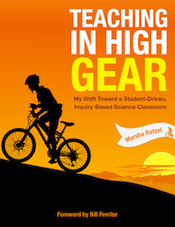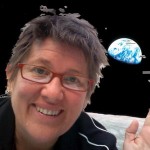My Epic Teaching Journey
Marsha Ratzel is a National Board-certified teacher in the Blue Valley School District in Kansas, where she teaches 6th & 7th grade science, math and sometimes social studies. She blogs at Reflections of a Techie and tweets with the handle @ratzelster.
Marsha’s first book, describing her journey to more student-centered, inquiry teaching and learning, is published by Powerful Learning Press. This excerpt was first posted at MiddleWeb in the summer of 2012 and updated based on the book’s final revisions in 2013. Learn more about Teaching in High Gear: My Shift Toward a Student-Driven, Inquiry-Based Science Classroom at the PL Press website.
by Marsha Ratzel
This year of action research — getting myself to the place where I could routinely carry out student-centered, question-centered instruction — was (to use a word from my mountain biking friends) EPIC! To a rider this means that I started on a journey that I thought would take a month or two, but it extended over the entire school year, and I’m sure the trip’s not over yet.

In teaching, my granny gears were those first timid steps I took, trying out something and seeing if it worked. One step was turning to students to provide some questions, which fueled the first investigations we did. Every teacher will have different ways of finding their own granny gears. It’s just important to look for them and not be afraid to set out because the way looks steep.
As I climbed higher in my teaching practices, I had to shift gears and learn to seek out colleagues who helped me figure out the questions to ask myself and strategies to get me up the hill. I had to rely on students telling me what they needed. All of this input kept me from face-planting (which is never a good thing) and got me back on the trail if things faltered a bit. My Personal Learning Network helped me find my “mo” (momentum).
With my PLN’s support, I was able to take the small successes that I was experiencing with students and build those into some bigger feats. As we finished the year, they were full of questions, and best of all, they felt capable of answering them.
“We Are the People Who Do the Hard Stuff”
It’s hard now to see those students as the same kids who had trouble withstanding not knowing exactly how to proceed. Not only were they able to survive the ambiguity, but by the end of the year, they began to thrive on it. My students became stronger, more self-confident and independent learners. I remember telling one of my kiddos: “We are the kind of people who do the hard stuff now, and if we wanted it easy we would have looked it up in a book.”
My students’ strength meant they were willing to dig down deep when what they really wanted was to quit. Some people never learn that finding the answer or doing something successful is mostly overcoming fear that it can’t be done. We broke through this barrier by creating a supportive classroom that fostered teamwork and curiosity.
When you talk about building relationships with students, it means so much more than getting to know each other. It means doing hard things together, so that you can anticipate where each person will need a little help and also where they can provide help themselves, based on their own strengths. Through this process, we developed confidence in ourselves and in one another.
My students today “get” that learning is a process. And while they may encounter moments where something doesn’t turn out the way they expected, they know how to change that into something positive. If students have a better idea than the one I present, they ask me to change things up. We co-create and co-learn with each other—we do the hard stuff.
I Feel That I’m a Totally Different Teacher
This style of coaching learners allows me to find the place where I can just “do” teaching. Like discovering what a student-empowered classroom looked like, it isn’t something that can be explained very well if you haven’t experienced it. But maybe it’s happened to you in some situation where you took on a challenge—a sport, a hobby, even having a child.
When you start shifting your classroom, just like in mountain biking, it’s all a technical undertaking. Small problems are magnified. Now, instead of being confounded by a narrow trail with rocks and too much sand, I have developed a natural sense of how to navigate these trails. More importantly, my younger partners on the trail know how to avoid spinouts as well because they’ve learned coping skills and problem-based inquiry alongside me.
Once you’ve tasted this kind of teaching—seen students learn so much more in your classes than they ever have learned before—then the fun of it, the reward of it, is so great that you strive to get back into this kind of flow every time you walk into the classroom. It changes the way you design lessons. You look for the same content, but you’re imagining different approaches that make it student centered. It becomes less about the teacher talking or showing how and more of the kiddos doing.
The End Is Just the Beginning
When I began, I thought there would be an ending place in this process. But the end I’ve shared with you here is really just the beginning. Each fall a new batch of kids will arrive and we will start anew. Each time the relational pieces—the trust, the common understanding of each other, the students knowing when they can push me and me knowing when I can push them—will need to be developed. On the other hand, the structure of my lessons does not have to be built from scratch. I only need to customize it to be responsive to the needs of each particular community of students.
My hope is to get my class in the Zone faster each successive year because I’ll be better at the instructional pieces of this approach. Over the summers, I’ll once again sit back, reflect, read through my student feedback, and figure out the destination of the next epic adventure and how to get there.
Like mountain biking, as soon as you get to the peak of one hill, you see another hill that sings to you. So you go through the journey again and again, to get to the top and see the next big vista spread out before you.






































Marsha,
First off, if this post has done anything, aside from sparking the reflection bug within me it has made me want to read your book! I am so proud to not only know you but to have worked with and alongside you! What an accomplishment, you are a true inspiration to those of us committed to sticking it out for the long haul and proof that commitment to life long learning is the way to go.
As I was reading this post it made me think of a song by one of my new favorite bands, Dawes.The song is called “How Far We’ve Come” and there is a line from this song that has always stuck out to me, and I believe connects to this post; “the only point of looking back is to see how far we’ve come.” I love this line because it shows that reflection is quite possibly the most powerful tool to keep us moving forward. Not to dwell in the past but to learn from it, to realize how far we’ve come, and to figure out where we are going next. I love the partnership you’ve created in your classroom and I dream of the day when every teacher in the world states with such conviction that “we are the people who do the hard stuff” and not only that, we do it together and it is okay (or dare I say even better!) if our answers aren’t the same, or how we get to those answers and that the answers are never endings but almost always beginnings. Lighting a fire in your students to “discover the answers for themselves” while you too find your own answers; what beautiful learning that is. Teach on, or shall I say learn on! Cannot wait to read more!
Beth
@mssandersths
Marsha! I am so proud and happy for you. You have always had the love of teaching. What lucky students to have you as their teacher.
Sandy Dunigan